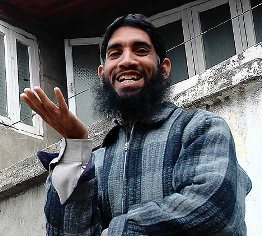After finally prying himself loose, zipper boy showed his obvious relief, although being super careful not to mishandle the delicate contents of his hand.
Previous instalments:
The First Annual Muslim Protest Awards
Zipper Boy III: The Wrath of Khan
Zipper Boy V: The Next Generation
Update: The picture is actually taken from this article, which paints him as an unfortunate soul who besides not being a very good “militant”, is pained by the killing of innocents, is against the sexual exploitation of women, and would love nothing more than to meet a nice infidel woman to convert to Islam and marry (hat tip: Soccer Dad).
His scary face now appears on boxer shorts and bumper stickers, and he scores more than a million results on Google.
Crazed: But the poster boy of Islamic radicalism has a very different story to tell when he’s at home with his mother
A regular spoof diary appears online in his name and he has come to stand for all that is most frightening about radical Islam.
But who is the real person behind the cartoon and what does he believe in? I travelled to Kashmir in search of the poster-boy of fundamentalism.
—-
Arriving at a simple, traditional three-storey Kashmiri house, I was taken up steep wooden steps by the light of a gas lamp to the top of the building. There, standing in an empty room, dressed in a salwar kameez and zip-up cardigan, with crooked teeth and a quizzical look on his face, was Islamic Rage Boy.
Shakeel Ahmad Bhat is a 29-year-old failed militant. Over two days, sitting cross-legged at the home he shares with his mother and smiling shyly much of the time, Shakeel told me, through an interpreter, his life story and why he had come to wave his fists at the cameras.
His story was not what I had expected and showed the personal torment of life in a society that has gone wrong. Although it is hard to prove the authenticity of his story, given my knowledge of Kashmiri political history over the past 20 years, everything he told me sounded plausible: after all, what reason would he have to lie?
Shakeel’s religious family followed the Sufi tradition, a mystical and tolerant form of Islam that is common in Kashmir. His father would often take him to mosques and taught him two lessons: do not be greedy and help Islam to spread by peaceful means.
Shakeel did not like school and he had difficulty learning to read and write. His teacher thrashed him with a stick but it did not improve his studies. Aged ten, he refused to go to class and stayed at home with his family.
At this time, in response to rigged elections, Pakistani-backed terrorist activity against Indian rule in Kashmir was beginning. The Indian government’s reaction was brutal. While searching for militants, police raided Shakeel’s home and threw his 18-year-old sister Shareefa out of an upstairs window. She broke her spine and died from her injuries four years later.
In the early Nineties, thousands of young Kashmiris streamed over the border to Pakistan to take up arms against India. Shakeel, just 13, decided to join them. He was so small he had to be carried on an older boy’s shoulders when he went up to the mountains.
In Muzaffarabad he was taken to a snow-covered training camp run by the Pakistani army in conjunction with the militant group Al-Umar Mujahideen. Armed with an AK-47, he returned to Srinagar hoping to drive out the Indian army.
“I thought Kashmir should have the right to self-determination,” he told me.
Shakeel was not a very good militant. When I asked him how many people he had killed, he looked embarrassed.
“I gave scares but I never killed anyone,” he said. “I couldn’t. I never hurled a grenade in a public place.”
His greatest achievement was opening fire on the cavalcade of a visiting Indian government minister.
Even when his team caught a police informant, Shakeel called for him to be set free. “I thought I would set an example. Forgiveness is better than killing.”
In 1994, when he was 16, he was arrested and taken to a military barracks. Of the 20 boys and young men who had crossed the border to Pakistan with him, only eight were still alive.
Shakeel was tortured. He was stripped, doused with water and given electric shocks. A nail was pushed through his jaw (he showed me the scar). His head was immersed in water.
When he was released, he remained under police surveillance. An injury to his right arm as a result of the torture had left him unable to lift anything and he has relied on his brothers to support him since then. Shakeel is still unemployed and says he feels as if he is 110 years old.
Not long after his release, the paramilitary Special Task Force came to the house to look for Shakeel but he was not there. They beat his 75-year-old father instead, leaving him with a broken leg; he spent the rest of his life bedridden.
While we were talking, one of Shakeel’s brothers brought in a pot of sweet tea and a plate of cakes. Since there was no furniture in the room, he spread out a plastic tablecloth on the floor and served me tea. It was evening by now, and the Kashmiri night was going to be cold. The brother brought in a rug and spread it over my legs.
Shakeel’s understanding of the world is limited by his inability to read or write. He likes going to demonstrations and has an ambition to start a political party.
“But not to be the puppet of Pakistan or India,” he insisted.
He sometimes watches Al Jazeera English on television and although he cannot comprehend much of what is said, he told me he can work out what is going on from the images on screen and from what his brothers have told him.
If something upsets him, he organises a demonstration.
He seems to be quite an idealist.
He has demonstrated against the Pope’s comments about Islam, against the sexual exploitation of Kashmiri girls, against police violence and ‘encounter’ killings and against the honouring of Rushdie. Why did he object to Rushdie being knighted?
“He has a reputation for Muslim-bashing,” he said solemnly. “Why is the London government encouraging someone who does these things?”
To my surprise, Shakeel seemed to have no time for Bin Laden, although he does not believe he was responsible for the 9/11 attacks.
“I heard that planes had crashed into the Twin Towers. I thought it was very bad that so many civilians had been killed. But afterwards I was told it was America’s own government that had arranged the attack.”
How could that have happened? “Money can make wonders.”
But why would America have wanted to do such a thing?
“There is a strong lobby in the USA that opposes President Bush. He wanted to attack Afghanistan and Iraq. He had to justify that to his own people.”
Then I asked if he had heard about the 7/7 bombings in London. “I heard that an Underground train was bombed. It pains me when innocents are killed. It pains me.”
When the Islamic Rage Boy phenomenon took off and Shakeel had his face reproduced all over the world, the local police got worried and brought him in for questioning.
“They had photocopies from the internet which they showed to me.”
They told Shakeel to stop going on demonstrations but he refused.
He says he was brought before one of Srinagar’s most senior police officers, who offered him an administrative job in the government, and said he would find him a girl to marry. I believe him – Indian authorities have a habit of trying to rehabilitate militants who are no longer an obvious threat.
“They said they would drop all the cases against me if I quit going to demos.” He refused.
I suggested to Shakeel that he must have been tempted by the prospect of a job and a wife – he was unlikely ever to get such a good opportunity again. He looked shy and covered his face with his hands.
“I want to marry a non-Muslim woman and convert her to Islam.”
Why? I asked.
In a moment that might have come straight out of the Borat film, he answered in a soft, serious voice: “I have been told that if I can convince a non-Muslim woman to marry me – but not convert her by force – then there will be a place for me in heaven.”
I suggested there might be some suitable candidates in Britain. “If the offer comes,” Shakeel said, “I am ready to accept it.”
Did he ever use the internet? “I don’t have knowledge of it. I cannot go to the internet shops and spend 30 rupees an hour.
I never board a bus, I walk to the city centre if I am going to a protest. I don’t smoke and I don’t take tea from tea stalls. If I need some money, I have to ask my brothers to give it to me.”
Since he is unable to read properly, I had presumed that Shakeel would have a limited idea of the extent of his internet fame. But he showed me a pair of folders.
Some friends had trawled through different sites and printed off computer-altered pictures of him.
Shakeel leafed through the pages: Islamic Rage Boy on clothes, being force-fed a pork chop, as a vampire, as a beer bottle, as a woman in a bikini, as ‘Jihady Idol’, as ‘Adolf Mohammed Rage Boy’, distended and jabbing his finger at a photographer above a quote from Christopher Hitchens: “It’s impossible to satisfy Rage Boy and his ilk. It’s stupid to try.”
One picture showed what looked like an American preacher holding a microphone while wearing a Rage Boy baseball cap. Shakeel stopped on an image of his face superimposed on a pig.
He looked profoundly shocked and upset by this picture. What did he feel?
“I surely get hurt when I see these pictures,” he said. “This is terrorism for me. The people who do this are showing their own culture, so why do they tell us that we are uncivilised?’
I asked what would stop him protesting. What would satisfy him? “If peace were to prevail in the entire world and people would understand the message of the Koran. You can’t bring peace by beating the drums or killing people,” he replied.
Certainly sounds different to the man portrayed in this previous article.




